Abstract
As things stand today, whether we like it or not, industry funding is on the upswing. The whole enterprise of medicine in booming, and it makes sense for industry to invest more and more of one's millions into it. The pharmaceutical industry has become the single largest direct funding agency of medical research in countries like Canada, the United Kingdom and the United States.
Since the goals of industry and academia differ, it seems that conflicts of interest are inevitable at times. The crucial decision is whether the public welfare agenda of academia, or the corporate research agenda of industry, should occupy center stage when they conflict.
There is enough evidence to show that funding by industry is very systematic, and results that are supportive of the safety and efficacy of sponsor's products alone get the funds. It is no surprise, therefore, that one finds very few negative drug trials reports published, and whatever are, are likely to be by rival companies to serve their commercial interests.
Renewed and continued funding by industry decides the future prospects of many academic researchers. At the same time there is now evidence that pharmaceutical companies attempt suppression of research findings, may be selective in publishing results, and may delay or stymie publication of unfavourable results. This is a major area of concern for all conscientious researchers and industry watchers.
Industry commonly decides which clinical research/trial gets done, not academia, much though the latter may wish to believe otherwise. It finds willing researchers to carry this out. This can be one area of concern. Another area of pressing concern is when industry decides to both design and control publication of research.
It makes sense for researchers to refuse to allow commercial interests to rule research reporting. Research having been reported, the commercial implications of such reporting is industry's concern. But, doctoring of findings to suit commerce is to be resisted at all costs. In this even pliant researchers need have no fear, for if they indeed publish what will work, the concerned sponsor will benefit in the long run. The only decision academia has to make is refuse to comply with predestined conclusions of sponsors for the ‘thirty pieces of silver’. Instead do genuine research and make sixty for themselves.
The useful rule of thumb is: Keep the critical antenna on, especially with regard to drug trials, and more especially their methodology, and study closely the conflict of interest disclosed, and if possible undisclosed, before you jump on the band wagon to herald the next great wonder drug.
There are three important lessons to be learnt by academia in all academia-industry relationships:
-
i)
Lesson number one: incorporate the right to publish contrary findings in the research contract itself. Which means, it makes great sense for academia to concentrate on the language and contractual provisions of sponsored research, to read the fine print very closely, and protect their research interests in case of conflict.
-
ii)
Lesson number two: a number of lawsuits successfully brought up against industry recently reflect earnest attempts by patient welfare bodies and others to remedy the tilt. It will result in a newfound confidence in academia that augurs well for academia industry relationship in the long run. Hence the second lesson for academia: do not get browbeaten by threats of legal action
-
iii)
Lesson number three: Academia should keep itself involved right from inception of the clinical trial through to ultimate publication. And this must be an integral part of the written contract.
The time to repeat cliches about the exciting future of the academia-industry connect is past. A concerted effort to lay a strong foundation of the relationship on practical ethical grounds has become mandatory.
Keywords: Public Welfare or Corporate Research Agenda, The Olivieri Case, Doctoring of Research Findings, Selective publishing, Delay and Under reporting, Complete Disclosure, Multi-centred Trials, Ghost writing, Duplicate Publication, Access to Data, Control over Publication, Negative Drug Trials, The Porcupine Dance, Law Suits Against Industry, Design and Control of Publication, Connection between Funding and Positive Findings
Introduction
As medicine marched onwards from being only an art to becoming an art based on scientific inputs, great contributions were made in diagnostics as well as therapeutics from numerous quarters. In both these areas, medical research has played a great role, as has the education, training and acumen medical practitioners imbibe from institutions, dedicated medical teachers, research publications and other means of upgrading knowledge like CME, conferences, workshops, annual meets etc. An area of increasing activity is by organized industry, which supports and funds major research and related ancillary/infrastructure development today. The pharmaceuticals have played a major role in organized industry, and their contribution cannot be ignored, nor sidelined, for they have been instrumental in placing at our disposal a huge arsenal of medications both effective and safe:
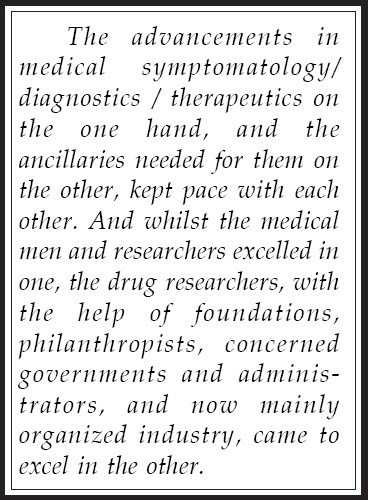
One of the striking characteristics in the medical field in the 20th century has been the development of new drugs, usually by pharmaceutical companies. Until the end of the 19th century, the discovery of new drugs was largely a matter of chance. It was in that period that Paul Ehrlich, the German scientist, began to lay down the principles for modern pharmaceutical research that made possible the development of a vast array of safe and effective drugs (Encyclopaedia Britannica, 2005).
The advancements in medical symptomatology/ diagnostics/therapeutics on the one hand, and the ancillaries needed for them on the other, kept pace with each other. And whilst the medical men and researchers excelled in one, the drug researchers, with the help of foundations, philanthropists, concerned governments and administrators, and now mainly organized industry, came to excel in the other. This has resulted in a vast advancement in, and organization of, an institution called modern medicine, with its paraphernalia of practicing physicians, researchers, academia and related industry and its appendages*.
Many in the pharmaceutical industry started with pioneering ideas of wanting to help mankind. (For example, Upjohn, the founder of the pharmaceutical by his name, began the use of true tablets/capsules, Worthen, 2000]. So did academia, and the physicians it produced. Somewhere down the line, industry decided to make profit its major focus, and to good reason, for it was a commercial venture. And profit in an open market economy is the sweetest sound to the ears, whatever the others may say, or crib about.
Academic medical institutions, and the products from its precincts, had to balance their needs for gain with notions of patient welfare, since they could not make, or at least declare, profit their main motive. Probably, if they too had, things would have been less problematic ethically. What they did, however, was try and balance the ethics of a professional guided by patient welfare, with the needs of an entrepreneur who needed the patronage and investment that big funding could provide. So they started lobbying, first with government which was the major source of funding earlier, and later with industry. As the scale of investment increased, government found it easier to hand over funding to industry, which in any case was catching up with events and waiting for its chance. And its chance did come, as government found funding for medical advancement too hot to handle. Instead, it decided to play an overseer role, a role that both suited it and was within its capacity.
Industry and academia, both of which were in the meanwhile becoming commercial enterprises, welcomed this development. Industry with open arms, academia with folded ones, at least overtly. Over the decades, whilst government has settled in its legislative role, industry has settled in its commercial one. Academia has still to settle in any role, since it wants to settle in a professionals’, but is compelled by the pulls and pressures of acting like an industry. The recent trend to run hospitals, and even academic institutions, along business lines is a step in the direction of seeing whether even medicine and medical research could become a business enterprise.
All said and done, it is a point worth serious consideration whether that may not be a worthy option to explore. Before a number of the well meaning get alarmed, let us clarify that this option may appear sacrilegious, but is very much in the offing, and prudence dictates either we resist it and know the implications, or accept it and enjoy the fruits. And when we do suggest prudence, we do not suggest no ethical parameters need be followed. But they will be as laid down in a business enterprise, not as in a profession. Meaning, thereby, profit will guide which patient welfare activities will be carried out, and not patient welfare decide where the profits will accrue from. Ultimately, market forces of a free economy, the great leveler, will decide which — profit or patient welfare, will prevail. If what profession feels today - that patient welfare alone will ensure long-term profits- is the truth, well, market forces will prove it. If, however, patient welfare is only an intermediate goal anyway (Singh and Singh, 2005), well, market forces will unravel that too. In any case, the ambivalence and confusion that prevails all around will at least disappear.
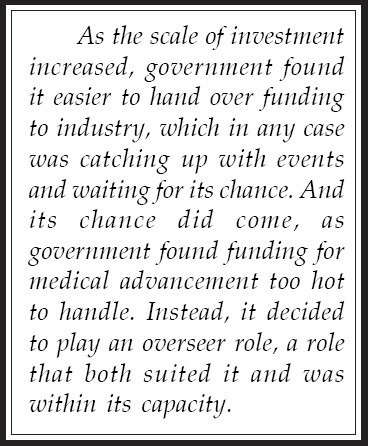
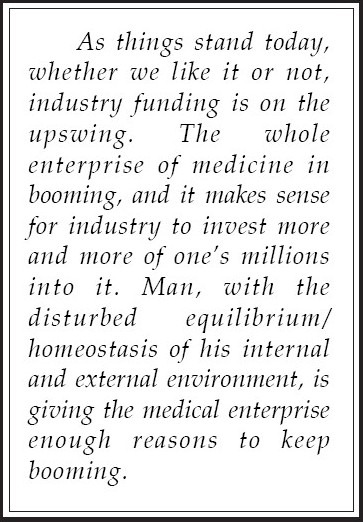
As things stand today, whether we like it or not, industry funding is on the upswing. The whole enterprise of medicine in booming, and it makes sense for industry to invest more and more of one's millions into it. Man, with the disturbed equilibrium/ homeostasis of his internal and external environment, is giving the medical enterprise enough reasons to keep booming. This is hardly likely to go bust, at least in the near future.
So it makes sound business sense to stay invested in this enterprise, even increase ones stakes. This, the pharmaceutical industry realizes very well indeed. This the enterprising academics and connected researchers realize very well too. And both would like to make hay as the sun shines. And keep fresh stock of hay ready, and keep the sun shining, if possible indefinitely.
In this monograph, we shall see how both sides are making the hay, how wholesome it is, and who is chewing the cud.
The great role that the pharmaceutical industry is playing today, and will continue to play in the future, can be gauged from the fact that it is the single largest direct funding agency of medical research in Canada, the United Kingdom and the United States (Collier and Iheanacho, 2002). The major drug research activity is occurring in these countries, and the implications of this finding should be obvious. Those who pump in their millions do so mainly for profit, and only incidentally for patient welfare. And, as we saw above, this trend is not likely to get reversed, at least in the near future. Which means this is likely to become the trend in other countries as well, India included. If this appears alarming to some, it must be sweet music to some others.
All in all, as things stand today, the enterprise called medicine is booming, and industry is playing a major role in this boom, whatever the doomsday prophesiers may lament, or rant, about.
Can Academia Call The Shots?
We mentioned earlier that the connect between academia and industry was a double-edged sword, and the prevailing ambivalence led to a typical ‘approach-avoidance conflict’ *(Singh and Singh, 2005; see also Montaner, O’Shaughnessy and Schechter, 2001). Let us take another example of the ambivalence that pervades academia, not that we ourselves are immune to it:
At its best, academic participation in the development of drugs leads to effective and safe new therapies (Baird, 2003). However, conflicts of interest are inevitable at times, because the goals of industry and of academia differ (Lewis, Baird, Evans,Ghali, Wright, Gibsons and Baylis, 2001).
Just saying that conflicts of interest between academia and industry are inevitable at times is acceptable as a statement of fact but not as a state of affairs. However the state of affairs can be remedied only if major leverage areas remain with academia. Evidence to that effect is sadly lacking at present. Whilst it is true that academia and industry must collaborate to develop newer and safer drugs, the problems come up when the so called newer drugs are just cosmetically different from the old, are not necessarily proven safe, but need to be hoisted on an unsuspecting patient population to keep proving the legitimacy of R and D departments, add to the impressive new drug tally of the company, and give a new potentially profit making tool to the marketing department, which can have another go at proving its legitimacy to those who matter.
The problem that comes up when boundary lines between academia and industry get blurred is well brought out by Angell (2000) below:
When the boundaries between industry and academic medicine become as blurred as they now are, the business goals of industry influence the mission of the medical schools in multiple ways. In terms of education, medical students and house officers, under the constant tutelage of industry representatives, learn to rely on drugs and devices more than they probably should. As the critics of medicine so often charge, young physicians learn that for every problem, there is a pill (and a drug company representative to explain it). They also become accustomed to receiving gifts and favors from an industry that uses these courtesies to influence their continuing education. The academic medical centers, in allowing themselves to become research outposts for industry, contribute to the overemphasis on drugs and devices. Finally, there is the issue of conflicts of commitment. Faculty members who do extensive work for industry may be distracted from their commitment to the school's educational mission (Angell, 2000).
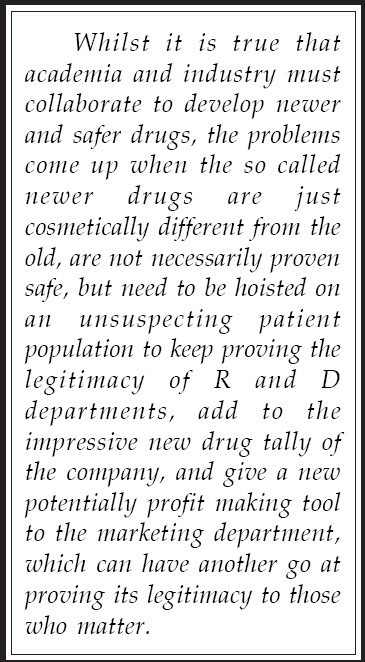
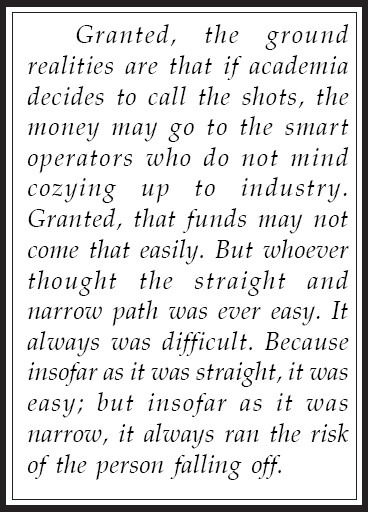
The crucial point is that the goals of academia and industry differ. And we purposely mentionacademiaandindustry, and not vice versa, to highlight what should be the state of affairs. It is academia which has to call the shots, it is industry which has to play second fiddle, and make its millions playing it. But it cannot be that in making its millions, it decides to also call the shots and decide what academia does or does not do. How does academia ensure this is a crucial issue. This, in spite of the analysis we presented in the introduction. Because, the analysis presents trends, which if understood, can either be forwarded or reversed. This thought supports the latter, and we shall see further how academia can really call the shots.
Granted, the ground realities are that if academia decides to do so, the money may go to the smart operators who do not mind cozying up to industry. Granted, that funds may not come that easily. But whoever thought the straight and narrow path was ever easy. It always was difficult. Because insofar as it was straight, it was easy; but insofar as it was narrow, it always ran the risk of the person falling off.
How things are accepted by pragmatic researchers is obvious from a recent paper in which the authors expect practical clinical trials in psychiatry, which they consider important, not to be funded by industry. This is not because they are not useful (even to industry), but because they may not serve their interests; in fact, may go against it:
Although a compelling scientific argument can be made for practical clinical trials funded by industry (fewer negative findings and more definitive answers to safety questions, among other reasons), it is unlikely, although not inevitably so, that pharmaceutical companies will pursue a practical clinical trials agenda in psychiatry if doing so will, in their perception, put profits at risk, even when the answers would be of substantial public health importance. Particularly whencomparing newer to older off-patent treatments, the risk of an adverse outcome (including a true tie) would be too great (March, Silva, Compton, Shapiro, Califf and Krishnan, 2005).
In other words, industry plays not a patient welfare but a profit welfare game, whatever academia may desire. In other words, academia realizes which research project will get the finances, and so will be guided accordingly. What are the implications of this trend in the future is anybody's guess.
Corporate Research Agenda Center Stage
Conflicts between the differing goals of academia and industry “put pressure on researchers to stretch — occasionally to the point of breaking — fundamental principles of ethical and scientific behaviour, and they may result in corporate research agendas, rather than the broader public agenda, being placed centre stage” (Baird, 2003).
There is no problem if all is hunky dory. The problem is that academia accepts that the public welfare agenda is hardly likely to motivate industry, and agrees to play ball accordingly:
… industry-sponsored research often fails to address broad public health needs or the needs of individual practitioners seeking to make good clinical decisions for individual patients. This shortcoming of industry-sponsored research is especially pertinent for decisions regarding risk, use of adjunctive treatments to improve partial response, maintenance and discontinuation of treatment, and transportability of treatments from the research to the clinical setting (March, Silva, Compton, Shapiro, Califf and Krishnan, 2005).
Issues like risk, adjuncts, maintenance, discontinuation and transfer to clinical use concern practitioners, but are not likely to motivate industry-sponsored research. What does mean? It means research agendas of industry are out of tune with needs of clinicians and patients, but still manage to determine what research gets done. Which also brings to the fore the schism between research developed in academia and practice done by clinicians. That, however, is a topic by itself. But what needs to be noted here is that industry and academia collaborate to produce much that has poor genuine clinical relevance to practitioners, although that does not at all mean new drugs do not get into the market, and sell well enough to produce industry dollars. Or research does not occupy center stage in academia and publications.
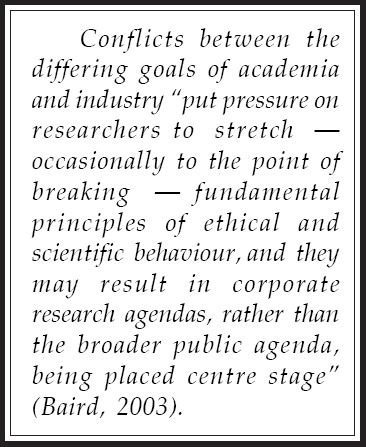
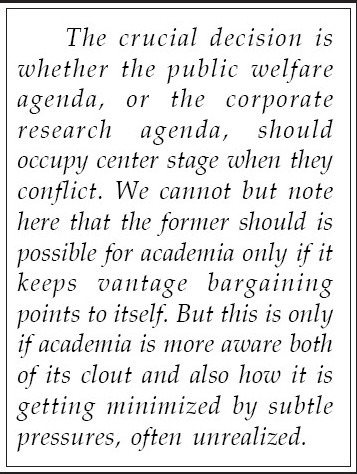
Well, if that is a paradox, it is one of the greatest unresolved paradoxes of our times in the field of medicine.
Public Welfare, or Corporate
The crucial decision is whether the public welfare agenda, or the corporate research agenda, should occupy center stage when they conflict. We cannot but note here that the former should is possible for academia only if it keeps vantage bargaining points to itself. But this is only if academia is more aware both of its clout and also how it is getting minimized by subtle pressures, often unrealized.
Many researchers profess that they are outraged by the very notion that their financial ties to industry could affect their work. They insist that, as scientists, they can remain objective, no matter what the blandishments. In short, they cannot be bought. What is at issue is not whether researchers can be “bought,” in the sense of a quid pro quo. It is that close and remunerative collaboration with a company naturally creates goodwill on the part of researchers and the hope that the largesse will continue. This attitude can subtly influence scientific judgment in ways that may be difficult to discern. Can we really believe that clinical researchers are more immune to self-interest than other people? (Angell, 2000).
Evidence that academia intends to keep vantage bargaining points to itself is sadly lacking at present. In fact as Boyd, Cho and Bero (2003) point out: faculty members are poorly informed even about campus conflict-of-interest or other institutional policies, in spite of it being on web sites, and staff meant to enforce it. This is the ostrich attitude at its best, or rather, worst. This is the result of the Boyd, Cho and Bero (2003) study:
Based on our interviews, it seems likely that faculty are poorly informed regarding their campus’ conflict-of-interest policies. Fewer than half of the faculty we interviewed could accurately state their institution's policy, even though the policies are posted on universities’ Web sites and staff at each institution are devoted to enforcing the policies( Boyd, Cho and Bero, 2003).
Now, if someone is ignorant of policy, he can hardly be expected to know its repercussions, or the problems he and others face because of this ignorance. That is a matter of obvious concern:
Because administrators depend on faculty to consistently disclose their relationships and because disclosure requires knowing when and what to disclose, these findings are of concern. If some investigators believe that they have no need to know the policy because they are not in conflict, then more must be done to educate investigators about both the specifics of relevant policies, as well as the nature of conflicts of interest( Boyd, Cho and Bero, 2003).
Educating them as to why it is essential is of course necessary, but some concrete steps so that they cannot get away with ignorance in this matter are necessary. A compulsory crash course highlighting academia-industry problem areas and how to resolve them is necessary before grants or projects get sanctioned. And matter on institution web sites should be regularly updated and become important reference source for such a course.
As awareness increases, investigators’ apprehensions, justified or otherwise, would be allayed, ensuring greater compliance, because ignorance today manifests both as a feeling of discrimination and skepticism, and they increase chances of noncompliance:
Furthermore, some faculty we interviewed perceived that the policies are inequitable because they are not consistently applied to all faculty. Such (mis)perceptions could also lead to noncompliance(Boyd, Cho and Bero, 2003).
Awareness of increase in academia industry conflicts of interest by education, remedial steps and an element of compulsion like a crash course (at least initially, to shrug off the lethargy), are urgent steps needed by academia if it desires the equation skewed against it at present to be set right.
Academia's naiveté
As we see the reality, academia is pretty naive in this regard, only too eager to hand over the initiative in conflict situations to industry, almost accepting that the sponsor can be tough and the recipient cannot:
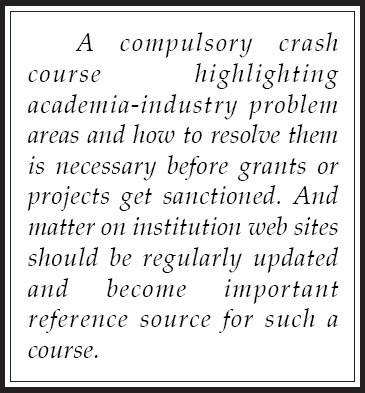
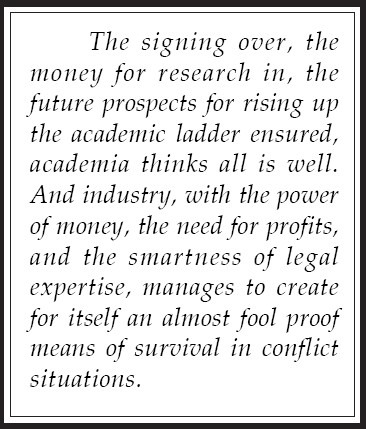
… when results are disappointing for a company, conflicts may develop. Dr. Furberg, with years of experience in industry-funded drug trials, stated: “Companies can play hardball, and many investigators can’t play hardball back. You send the paper to the company for comments, and that's the danger. Can you handle the changes the company wants? Will you give in a little, a little more, then capitulate? It's tricky for those who need money for more studies” (Bodenheimer, 2000).
This is obvious as much in the disinclination to fight back as in the bored resignation academics show in reading agreement documents with industry, as well as in not consulting lawyers who will protect their interest, and in being too eager to sign on the dotted line for the carrot of the sponsorship cheque dangling so invitingly in front. It is essential to note that academia-industry transactions are like any business deal wherein the agreement contract is to be carefully perused to ensure ones interests. As Drazen (2002) points out:
No matter how altruistic the motive, investigators must recognize that research performed under these contracts is a business transaction. It is imperative that the terms of such contracts guarantee the safety and confidentiality of patients while preserving the academic independence of participating investigators.
However, academia can be quite complacent in this matter. The signing over, the money for research in, the future prospects for rising up the academic ladder ensured, academia thinks all is well. And industry, with the power of money, the need for profits, and the smartness of legal expertise, manages to create for itself an almost fool proof means of survival in conflict situations. This is aided no end by academia's strong belief still that it can recognize and handle conflict of interest situations, and regulate its behaviour, even in the face of evidence that they may be underestimating the risks to the integrity of research. As Boyd, Cho, and Bero, (2003) point out:
Although most clinical investigators in our study recognized that financial relationships with industry sponsors pose possible conflicts of interest, many believed strongly in their own ability to recognize these conflicts, avoid bias, and regulate their own behavior.
Going on to analyse this attitude, they describe the peculiar denial academia manifests:
Investigators have this attitude despite the publicity that has been given to a few high-profile cases involving the suppression of research by investigators with financial ties to companies (Nathan and Weatherall, 2002; Rennie, 1997 ) . The investigators’ expressed belief that risks of conflict of interest do not apply to themselves, a viewpoint that is consistent with their support for self regulation.(Parenthesis added).
Their caution that follows is worth more than a cursory look:
However, the well-publicized risks, mentioned above, and the data on the association of funding and financial ties with outcomes of research (Cho and Bero,1996; Barnes and Bero, 1997; Barnes and Bero ,1998) suggest that investigators may be underestimating the risks to the integrity of their research. Furthermore, these views may ultimately undermine the effectiveness of institutional policies. (Parenthesis added).
And the concluding remarks make eminent sense, for they recommend that potential for bias, conflict and pressure be seriously recognized in all academia-industry ties:
Insofar as investigators believe in their own abilities to “handle” conflicts of interest, policies may be perceived (and perhaps treated) as irrelevant. Thus, a fundamental challenge facing administrators and policymakers is to demonstrate to all investigators, both clinical and nonclinical, that the potential for bias, pressure, and conflict is relevant to all investigators with industry relationships(Boyd, Cho and Bero, 2003. Parenthesis added.).
This situation needs some measure of urgency from academia, which is in the know of things but resists acting on it. Let us see the other manifestation of denial pointed out by another recent paper:
Although industry sponsors provide approximately 70 percent of the funding for clinical drug trials in the United States, little is known about the legal agreements that exist between industry sponsors and academic investigators (Mello, Clarridge, Studdert, May, 2005).
Little is known about the legal agreements. This in May, 2005. Why? What's the reason? What's there to conceal? Who is concealing it, and why? Will serious academics deliberate over this state of affairs?
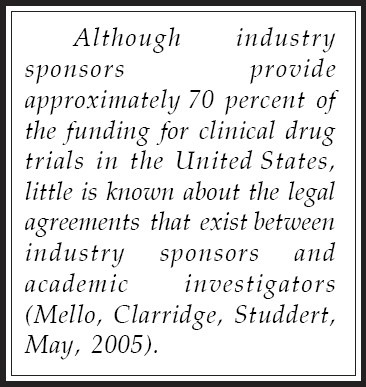

Contrary Findings and The Olivieri Case
The need to protect its right to publish finding even if contrary to industry interests is a crucial determining factor with regard to forwarding the public welfare agenda. How many from academia can stand up and ask for it is a crucial factor. How many remain ever vigilant not to allow research agendas to be hijacked by industry is another crucial factor. How many have the nerve to support colleagues who stand by public welfare and are hauled to court for it, or smeared as to their credentials for it, is still another crucial factor.
The way in which many from academia played into the hands of industry in the recent Nancy Olivieri case (see Baylis, 2004; Schafer, 2004) is a sad commentary on how money and grants rule the minds of academia at the cost of patient welfare. In so far as that is happening, the earlier situation of conflict between academia and industry has been wonderfully well resolved. For it no longer obtains, academia having submitted tamely to industry's demands. How usefully is the issue resolved for society and patients is for many, well, an embarrassment better swept under the carpet.
But the situation is not necessarily that bad, for the soul searching that the Olivieri case has brought about in academia is a promising fall out of the murky events that led to, and also followed, the whole affair. The Olivieri Symposium in the Journal of Applied Ethics is a welcome addition (three articles from there worth a close look are Baylis, 2004; Schafer, 2004; Faunce, Bolsin, Chan, 2004), as is the discussion in various forums and research journals of its pros and cons.
The Schafer (2004) comment in which he takes a close look not only at haematologist Nancy Olivieri's case but even the equally alarming one of psychiatrist David Healy is worth a close look here. He talks about the common elements in both episodes, and the shady role that well known pharmaceuticals played. This is a gist of what he says:
Not coincidentally, the Olivieri and Healy scandals share in common a number of key elements:
Wealthy and powerful drug companies hover in the background of both, and sometimes occupy a good deal of the foreground, as well: Apotex in the case of Olivieri, Eli Lilly in the case of Healy.
These drug companies not only fund university and hospital researchers, they are also major donors to the institutions within which researchers carry out their clinical studies.
Neither Apotex nor Eli Lilly was happy to have adverse information about their drugs publicized (Schafer, 2004)
Talking of the negative consequences the two experienced for promoting the patient welfare agenda, he mentions how both industry and academic institutions ganged up to discredit the two researchers:
Both Olivieri and Healy personally experienced serious negative consequences from their willingness to speak publicly about potential dangers to patients.
Each of them appealed for assistance, unavailingly, to the senior administrators of the University of Toronto and its Faculty of Medicine. Although there had been a changeover of university presidents and medical faculty deans in the interval between these two scandals, personnel changes made very little difference to the university's official response.
In both scandals, university and hospital officials failed to recognise that there had been a fundamental violation of the principle of academic freedom at the affiliated hospitals (Schafer, 2004).
The way institutions where the researchers worked (Olivieri), or were to get connected (Healy), behaved is straight out of a movie thriller:
In both cases, the whistleblowing physicians found themselves removed from their positions: Olivieri was fired from her position as director of the Hemoglobinopathy Research Program at Sick Kids’ Hospital; Healy's employment contract with both CAMH and the University of Toronto's Department of Psychiatry was terminated.
-
Both hospitals and the university denied strenuously that these “firings” were in any way related to the whistle blowing (Schafer, 2004).
And to ensure the movie would be a sure hit:
Damaging rumours were circulated among Olivieri's colleagues, including allegations that she was scientifically incompetent, guilty of stealing money from her research grants, unethical in her patient care and sleeping with some of the scientists who looked favourably on her research findings; damaging rumours were circulated about Healy that he was a bad clinician, and both a racist, and a member of a cult known as Scientology. A journalist who telephoned me for an interview at the height of the Healy controversy asked whether I knew that Healy was a prominent Scientologist. Her previous interviewee had been a hospital spokesperson who was circulating that piece of disinformation among the media, presumably in an effort to discredit Dr Healy.
The perpetrators of these false but damaging accusations against Olivieri and Healy mostly preferred to remain anonymous (Schafer, 2004).
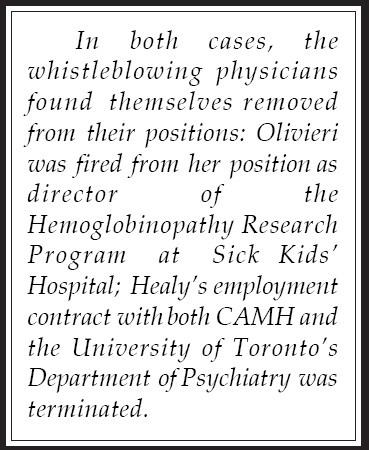
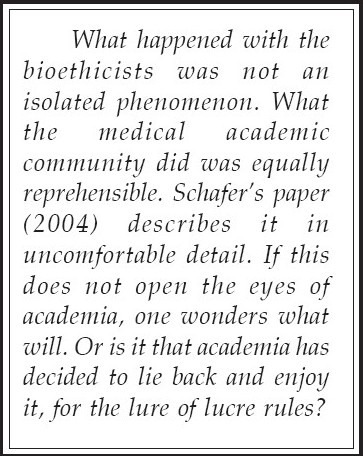
How much further will academia bow down to, and ingratiate itself, for a few pieces of silver? How often would Judas’ stories get repeated, and Christs crucified?
And the Baylis (2004) comment on fellow bioethicists who maintained a stony silence while the Olivieri episode raged is equally unsparing:
Bioethicists in Canada failed Dr Olivieri and her colleagues at HSC. Why? Did they fear losing their jobs? There are few bioethicists who have the security of tenure. Did they fear being sued? Many of the individuals and organisations involved in this case had shown themselves willing to engage in litigation. Did they fear loss of reputation? Again, many involved in this case had shown themselves willing to make damaging public comments. Did they fear retribution and consequent damage to their careers? After all, bioethics in Canada is a very small and fractured community. I do not know the reason(s) for the ensuing silence. I do know, however, that by and large Canadian bioethicists failed to speak up when there was ample time and opportunity. As a responsible community, we must ask ourselves whether we could and should have done more.
What happened with the bioethicists was not an isolated phenomenon. What the medical academic community did was equally reprehensible. Schafer's paper (2004) describes it in uncomfortable detail. If this does not open the eyes of academia, one wonders what will. Or is it that academia has decided to lie back and enjoy it, for the lure of lucre rules?
Decide. It's a trifle urgent.
Doctoring of Research Findings
Let us move on to the way suppression of findings contrary to a company's interests occurs. “It is an area of increasing concern that when clinical research results are contrary to a company's interests, conflicts are more likely to develop, and there are numerous documented instances in recent years in Canada of attempted suppression of research findings by pharmaceutical companies” (Skolnick, 1998; Downie, Thompson and Baird, 2001). (Baird, 2003).
The recent paper by Mello, Clarridge, Studdert (May, 2005) makes the point equally clearly in the case of the AIDS vaccine, Remune, about which the researchers concerned filed negative reports and had to face legal action by the sponsor:
In September 2000, Immune Response, a biopharmaceutical company, filed a $7 million legal action against the University of California at San Francisco after researchers published negative findings from a clinical trial of the company's experimental acquired immunodeficiency syndrome (AIDS) vaccine, Remune. The investigators had refused to allow the company to insert its own statistical analyses into the manuscript (Saltus, 2000). Immune Response demanded that the researchers not publish the article and withheld some of the data in an effort to dampen their publication prospects (Hilts ,2000). The investigators succeeded in publishing (Kahn, Cherng, Mayer, Murray and Lagakos, 2000) but subsequently faced a legal battle that ended only after the university filed a counterclaim alleging that thecontract between the parties gave the researchers permission to publish (Lee, 2001)( Mello, Clarridge and Studdert, 2005. Parenthesis added.)
What was interesting was that the permission to publish was, fortunately, part of the agreement. And, equally fortunately, the academic institute stood by the researchers, not the sponsors, regardless of consequences. A few more researchers of this ilk, and a few more institutions which support them, and the problem may not remain that grave at all. The time to give weak-kneed responses to sponsors is past.
The Remune case, other high-profile clashes between academic researchers and pharmaceutical sponsors (Rennie, 1997; Shuchman, 1998; Hailey, 2000): and recent controversies concerning the disclosure of unfavorable findings in studies of antidepressants in children (Meier, 2004) and rofecoxib (Topol, 2004) have elevated concerns about industry-sponsored trials (Angell, 2004;Drazen, 2002; Bodenheimer, 2000; Nathan and Weatherall, 2002). Because conflicts often turn on the language of the clinical-trial agreement, they illuminate the potential consequences of contractual provisions that restrict academic investigators’ control over trials (Mello, Clarridge and Studdert, 2005. Parenthesis added.)
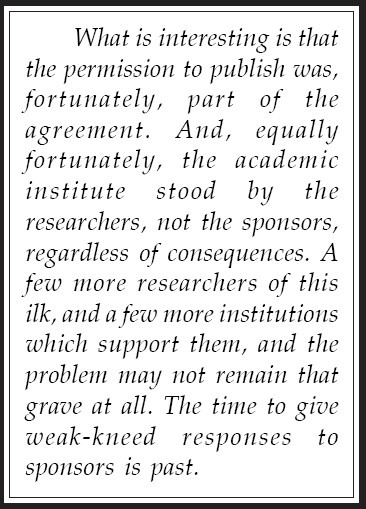
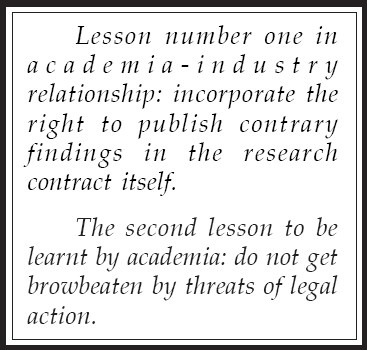
Which means, it makes great sense for academia to concentrate on the language and contractual provisions of sponsored research, to read the fine printvery clearly, and protect their research interests in case of conflict. In particular, a provision to publish contrary findings must be inbuilt in any academia-industry contract. This is so as to avoid pressures that may not allow the investigator to publish them later, and in general retain control over the trial results. If only the agreement had no clause to publish contrary findings, the researchers and the academic institution in the Remune case would have landed themselves in a big soup by acting in patient welfare. Since it was, sponsors had to back track after showing the customary legal scare.
Hence, lesson number one in academia-industry relationship: incorporate the right to publish contrary findings in the research contract itself.
The Remune case is only one in a succession of many others. Skolnick, (1998), in an earlier paper, for example, talks of a pharmaceutical firm suing a statutory body in Canada so as to prevent publication of findings about its cholesterol-lowering statin drug called Pravachol:
A CANADIAN appeals court has upheld a lower court's decision denying a pharmaceutical company's motion to block publication of a health technology report that the company contends may damage its commercial interests.
In December 1997, Bristol-Myers Squibb Canada Inc sued the Canadian Coordinating Office of Health Technology Assessment (CCOHTA) to prevent the release of its summary report on cholesterol-lowering statin drugs. The company contends that the report contains “negligent misstatements” that could negatively affect the sale of its drug Pravachol (pravastatin) (Skolnick, 1998).
Malignant misstatements! What do not suit commercial interests become malignant misstatements. The bluff was exposed soon after:
When the Ontario Court denied Bristol-Myers Squibb's motion for an injunction to suppress the report in March, the company appealed. On May 6, an appeals court upheld the lower court's decision and CCOHTA promptly published the report, A Clinical and Economic Review of HMG-CoA Reducatase Inhibitors in Coronary Heart Disease, which was based on a technical review of published clinical trials and pharmacoeconomic evaluations (Skolnick, 1998).
So, the contrary findings were published. The legal threat was exposed for what it was: an attempt to intimidate.
The second lesson to be learnt by academia: do not get browbeaten by threats of legal action.
If lesson number one is learnt well, lesson number two is easy to implement.
Selective publishing, delay
Legal threat is not the only method industry adopts to ensure compliance. In the case of those researchers who depend on industry to decide about publication, or hand over their work to them because of whatever compulsions, they had better note another mechanism used by them. Companies may be selective in publishing results, and they may delay or not publish unfavourable results at all (Stelfox, Chua, O’Rourke and Detsky, 1998; Chalmers, 1990; and Stern and Simes, whose 1997 paper in the BMJ is titled: Publication bias: evidence of delayed publication in a cohort study of clinical research projects). Which, in essence, means publish and rise as long as you publish what suits me. If not, well, I can stymie your publication, your research and even your future. Academia will have to decide how far will it go in this regard, and take suitable corrective steps with some alacrity. The two lessons learnt earlier should help academia in this direction.
The moot point also is to note the above statement: Companies may be selective in publishing results, and they may delay or not publish unfavourable results at all. Companies? Do companies decide publication? What do researchers do? Only do the trial, report the finding to the company, and wait for them to use it whatever way they desire? Well, if that is how it is to go, why should academia crib about doctoring of research findings? Rather, it should expect it, may be even welcome it. For, handing over findings so obediently, or rather professionally, ensures continued industry sponsorship but also ensures continued doctoring. Why does academia abdicate its responsibility in this regard?
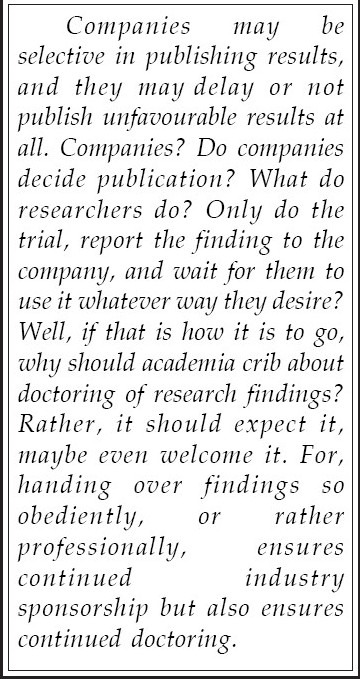
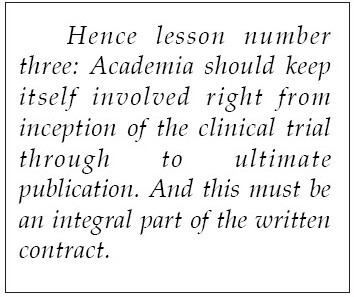
This calls for some soul searching. The remedy which comes to mind is for academia not to hand over findings, but to insist on working over the research right from methodology through to statistical analysis and eventual publication, not handing over charge at any stage. Well, does that ensure funds to academia? It does, because if what are legitimate findings are published, the concerned sponsor will know whether the product indeed has business potential, or is just a red herring. And will be on the right track to pump in his millions to market it.
Hence lesson number three: Academia should keep itself involved right from inception of the clinical trial through to ultimate publication. And this must be an integral part of the written contract.
Under Reporting
Let us come to another scientific impropriety. Chalmers (1990), for example, points out that under reporting of clinical trials is a form of scientific misconduct:
Substantial numbers of clinical trials are never reported in print, and among those that are, many are not reported in sufficient detail to enable judgments to be made about the validity of their results. Failure to publish an adequate account of a well-designed clinical trial is a form of scientific misconduct that can lead those caring for patients to make inappropriate treatment decisions (Chalmers, 1990).
Publishing only positive findings, fudging with figures or reporting incomplete figures to suit predestined conclusions, making convenient conclusions from insufficient data are some related forms of scientific misconduct that serious researchers have to keep away from, much though market forces may try to convince academia to do otherwise.
The above author enjoins upon all concerned to take concerted steps to prevent underreporting by prospective registration of trials, amongst other things:
Investigators, research ethics committees, funding bodies, and scientific editors all have responsibilities to reduce underreporting of clinical trials. An extended useof prospective registration of trials at inception, as well as benefiting clinical research in other ways, could help people to play their respective roles in reducing underreporting of clinical trials (Chalmers, 1990).
As regards other related forms of scientific misconduct, it makes sense for researchers to refuse to allow commercial interests to rule research reporting. Research having been reported, the commercial implications of such reporting is industry's concern. But, doctoring of findings to suit commerce is to be resisted at all costs. In this even pliant researchers need have no fear, for if they indeed publish what will work, the concerned sponsor will benefit in the long run. The only decision academia has to make is refuse to comply with predestined conclusions of sponsors for the ‘thirty pieces of silver’. Instead do genuine research and make sixty for themselves.
Complete Disclosure
Another area that maybe a sore point for some on both sides is what and how much to make public in the academia-industry relationship. Stelfox, Chua, O’Rourke and Detsky, (1998) are categorical when they support complete disclosure of industry relationships after their study found positive correlation between author's opinion and financial relationship with the industry concerned:
Our results demonstrate a strong association between authors’ published positions on the safety of calcium-channel antagonists and their financial relationships with pharmaceutical manufacturers (Stelfox, Chua, O’Rourke and Detsky, 1998).
Their suggestion of a more effective conflict of interest policy and complete disclosure of industry relations is worthy of implementation:
The medical profession needs to develop a more effective policy on conflict of interest. We support complete disclosure of relationships with pharmaceutical manufacturers for clinicians and researchers who write articles examining pharmaceutical products (Stelfox, Chua, O’Rourke and Detsky, 1998).
Well, if someone has objections, let him ask himself what that means.
Multi-centred Trials
Another area of concern, especially in multi-centred trials or collaborative studies, is that industry sources often analyse the data collected from different centres, and the authors may not have access to the complete data, neither may they have control over what data is likely to be utilized, and what findings published. “Clinical trials now often include many centres, and potential for bias is clear, as the company often collates and analyzes the data. The listed authors may not have seen the complete data set”(Bevan, 2002). (Baird, 2003)
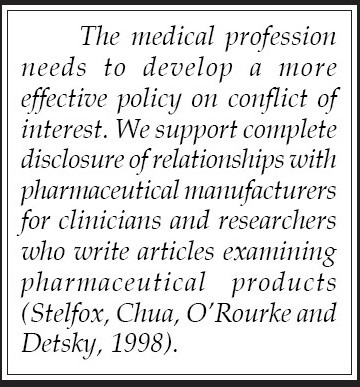
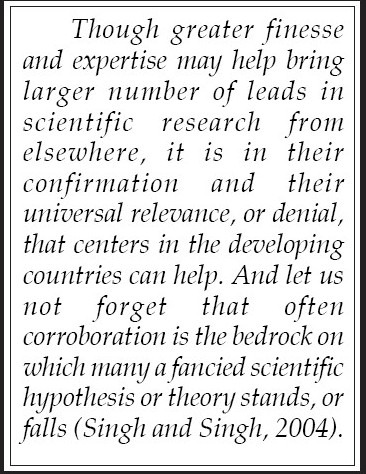
It is essential for all researchers to beware the trap of the easy way out: handing over of research findings to be worked over by the glib talking research departments of industry. The ease of getting things done may please be forsaken for the welfare of their own research credentials, if nothing else. For doctored writing based on fudged results are hardly likely to stand the scientific scrutiny of peers and replicative studies. Here, well-planned corroborative research can play a major role, even if it is not original. And centers in developing countries can have an important role to play here:
Though greater finesse and expertise may help bring larger number of leads in scientific research from elsewhere, it is in their confirmation and their universal relevance, or denial, that centers in the developing countries can help. And let us not forget that often corroboration is the bedrock on which many a fancied scientific hypothesis or theory stands, or falls (Singh and Singh, 2004).
Ghost Writing, Duplicate Publication and Industry
Ghost writing is another area worth a look. Bevan (2002) says, “Biomedical journals communicate new information that changes health-care decisions. If authors ignore the fundamental values of honesty and trust, that information becomes flawed, and society or patients may be harmed”. He describes something very interesting, and equally alarming, when he discusses two cases, one of duplicate publication, another of ghost writing, both representing the soft under belly of research. He touches, we suspect, the tip of an iceberg. By describing two cases of unethical behaviour by authors, and using them as a focus to review acceptable ethics in publication, he aims to educate readers who have not considered the ethical implications of writing manuscripts for biomedical journals:
Two cases of unethical behaviour by authors occurred when the results of new drug trials were reported. They were discovered after publication in a biomedical journal, and in the review process after the submission of a manuscript for publication respectively. In the first case, duplicate publication was identified because the same control data were used, but not acknowledged, in three publications by the same investigators. In the second, ghost writing by a pharmaceutical company writer was suspected because of the atypical presentation of a senior author's work (Bevan, 2002).
The result was interesting:
The editor consulted with the authors of both reports. In the first case, the authors concurred about the duplication, and the editors of the three journals wrote editorials to record the duplicate publications. The second case of ghost writing was unconfirmed by the authors, but the submission was withdrawn, and the article was later published in another journal (Bevan, 2002).
What they conclude needs deliberation:
These cases draw attention to recently recognized types of scientific misconduct that influence the perception of scientific work. Duplicate publication and ghost writing not only deceive the reader, but may also conceal flawed study design and conflict of interest (Bevan, 2002).
Duplicate publication and ghost writing need to be acknowledged and exposed for what they are. Forms of scientific misconduct. And no amount of cynicism about its inevitability should be allowed to cloud ones judgment here.
Access to Data and Control Over Publication
Another area of concern we briefly touched upon earlier was access to clinical trial data, especially in multicenter trials, by site researchers. A relatively recent survey from November 2001 through January 2002 (Schulman, Seils, Timbie, Sugarman, Dame, Weinfurt ,Mark, and Califf,2002)of 108 medical schools in the United States showed that only 1% of the site researchers surveyed had access to all of the trial data and only 10% had control over plan for data collection and monitoring. And these were medical schools and members of the Association of American Medical Colleges, which is supposed to adhere to the new ICMJE guidelines. This is what Schulmanet al( 2002)did:
From November 2001 through January 2002, we interviewed officials at U.S. medical schools about provisions in their institutions ‘agreements with industry sponsors of multicenter clinical trials. A subgroup of the respondents were also asked about coordinating-center agreements for such trials.
And this is what they found:
Of the 122 medical schools that are members of the Association of American Medical Colleges, 108 participated in the survey. The median number of site-level agreements executed per institution in the previous year was 103 (interquartile range, 50 to 210). Scores for compliance with a wide range of provisions — from ensuring that authors of reports on multicenter trials have access to all trial data (1 percent [interquartilerange, 0 to 21]) to addressing the plan for data collection and monitoring (10 percent [interquartile range, 1 to 50]) — demonstrated limited adherence to the standards embodied in the new ICMJE guidelines. Scores for coordinating-center agreements were somewhat higher for most survey items (Schulman, Seils, Timbie, Sugarman, Dame, Weinfurt, Mark, and Califf, 2002).
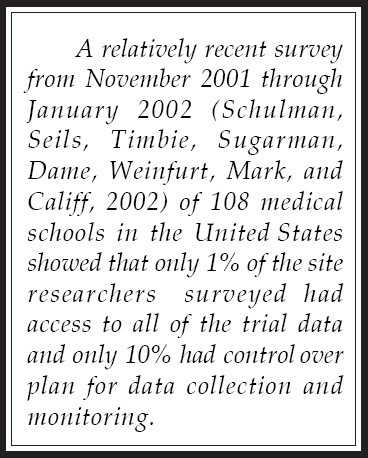
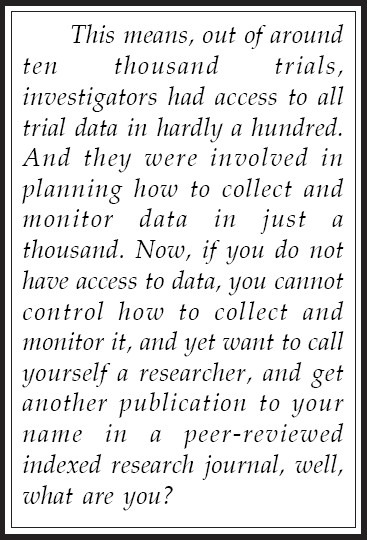
Site-level agreements: 103. Access to trial data: 1%. Plan for data collection and monitoring: 10%. Number of clinical trials: 108 × 103 = 10,024.
This means, out of around ten thousand trials, investigators had access to all trial data in hardly a hundred. And they were involved in planning how to collect and monitor data in just a thousand. Now, if you do not have access to data, you cannot control how to collect and monitor it, and yet want to call yourself a researcher, and get another publication to your name in a peer-reviewed indexed research journal, well, what are you?
Negative Drug Trials and the Porcupine Dance
It is no surprise, therefore, that one finds very few negative drug trials reports published, and whatever are, are likely to be by rival companies to serve their commercial interests.
Academic researchers are caught in an unenviable position. They want the funds but do not want the accountability and hassles that follow utilization of someone's money. They want to keep their accountability towards patients, while the sponsor wants it towards his welfare. They want the funds to continue to flow for their research depends on it, as does their career, but they want the freedom to report contrary findings. They want to listen to the voice of their conscience and go ahead and publish those findings contrary to industry interests, but they do not want legal hassles, and the reputation of a difficult guy to manage, that must invariably follow. And the temporary, and sometimes even permanent, brakes that may get applied to an otherwise promising career by such conscientious reporting.
So the smart guys learn to play the game pretty fast. They either avoid ruffling feathers or learn to ‘dance with the porcupines’ (Lewis, Baird, Evans, Ghali, Wright, Gibsons and Baylis, 2001; Wager, 2003). Like the porcupine's quills, drug companies’ interactions with doctors are numerous and can be harmful if approached the wrong way (Wager, 2003).
Lewis, Baird, Evans, Ghali, Wright, Gibsons and Baylis (2001) warn to dance carefully with the porcupine if the precious commodity called intellectual integrity is to be protected by academia. While proposing certain guidelines, they expressly warn against allowing industry to dictate what to investigate, which methodology to use, and how to express results:
Not infrequently, universities encounter challenges, veiled in the language of increased accountability, to their freedom of inquiry and expression. The claim that proposed constraints would be fatal to the academic mission becomes hypocrisy if universities allow industry to define the nature of inquiry, dictate methods and shackle expression. An industry–university contract is a transaction, and our proposed rules are designed principally to protect the university's most precious commodity: intellectual integrity (Lewis, Baird, Evans, Ghali, Wright, Gibsons and Baylis, 2001)
So, the academia-industry transaction can never be at the cost of intellectual integrity of academia. And academia knows precisely well what that means.
This does not mean all academia-industry contact be forsaken, or condemned. It only means protecting it from nefarious influence and leaving no loopholes for pliant researchers, and manipulative sponsors, to get away with research impropriety. And if loopholes are not plugged, it does not take long for the list of pliant researchers and manipulative sponsors to swell, with fresh recruits coming from the ranks of erstwhile conscientious researchers. Such guidelines ensure improved industry behaviour and minimize research misconduct by academia. Moreover, they also help reduce the atmosphere of paranoia and consequent aggressive names calling that can result as a sequelae from both quarters:
We are not asking academic researchers to forswear all interactions with industry. We are merely proposing rules for exercising due diligence to protect the essence of academic inquiry. A positive effect of the proposed rules would be voluntarily improved industry behaviour, with enlightened companies adopting honourable codes of conduct that in time may mitigate the wariness and cynicism that recent aggressions have doubtless engendered (Lewis, Baird, Evans, Ghali, Wright, Gibsons and Baylis, 2001).
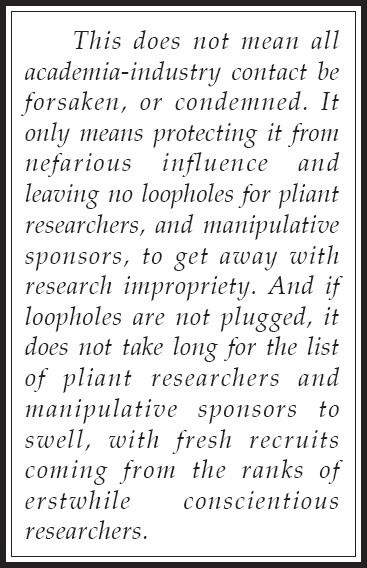
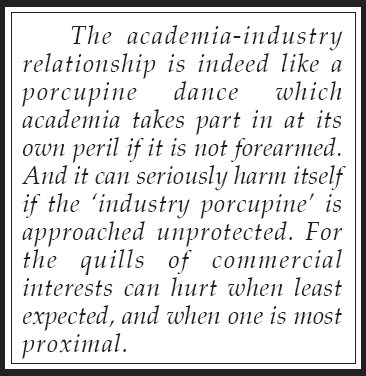
And a relationship based on mutual respect, which is professional enough to work but at arms length enough not to get sullied, is but appropriate:
All of this is not to gain say the importance of the spectacular advances in therapy and diagnosis made possible by new drugs and devices. Nor is it to deny the value of cooperation between academia and industry. But that cooperation should be at arm's length, with both sides maintaining their own standards and ethical norms. The incentives of the marketplace should not become woven into the fabric of academic medicine. We need to remember that for-profit businesses are pledged to increase the value of their investors’ stock. That is a very different goal from the mission of medical schools (Angell, 2000).
The academia-industry relationship is indeed like a porcupine dance which academia takes part in at its own peril if it is not forearmed. And it can seriously harm itself if the ‘industry porcupine’ is approached unprotected. For the quills of commercial interests can hurt when least expected, and when one is most proximal. So dance carefully with the porcupine:
Some bargains are Faustian, and some horses are Trojan. Dance carefully with the porcupine, and know in advance the price of intimacy (Lewis, Baird, Evans, Ghali, Wright, Gibsons and Baylis, 2001).*
Faustian, indeed. For one need not, but may, run into a pact with the Devil*. And the struggle between the higher and lower nature in man that academia-industry connect arouse may even make Goethe squirm in his grave.**
The Trojan horses are implanted in academia's midst all the time***. And it behooves academia to ferret such out. As it also behooves some amongst them to become Trojans themselves!****
Wager (2003) has her own views on how to ‘choreograph’ the porcupine dance. She suggests guidelines developed jointly by medical men both in academia and industry so that misapprehensions and misunderstandings on both sides can clear and wider acceptance of guidelines prevail:
What can we conclude about regulations designed to choreograph the porcupine dance? Most were developed only recently, and many are still evolving. They come from many organisations with different aims and are therefore scattered and occasionally conflicting, although consensus seems to exist on the broad principles. From my own experience of more than a decade of working closely with the industry and with doctors, misapprehensions and misunderstandings persist on both sides. I would therefore urge proper dialogue between the parties before any more guidelines or regulations are drawn up or revised. Guidelines developed jointly by doctors working both inside and outside the industry might be more widely accepted than those from a single constituency (Wager (2003).
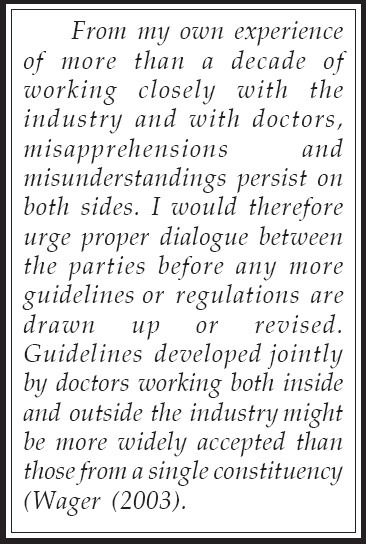
She opines further that the dance is complex, it cannot exclude any party, it is necessary for it is useful, and it is improper to smear all of industry:
Drug companies, like porcupines, come in a range of shapes and sizes; some are fiercer than others, and this diversity must be recognised. The relationships between doctors, academic institutions, pharmaceutical companies, and medical journals will always be complex and interdependent, but we should not forget that the dance has produced some remarkable collaborations that have enabled the discovery and development of the medicines we all rely on (Wager, 2003).
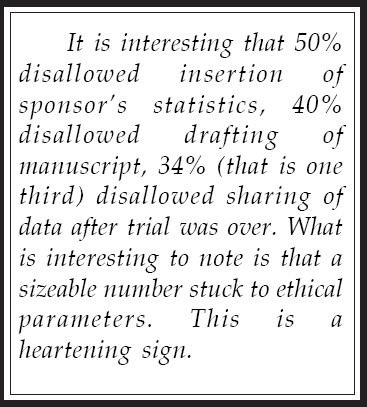
A reasoned response that looks for the silver lining. Hopefully it is not an illusion. But more of that in the next monograph.
Remedial measures
Attempts to remedy this situation have begun as more awareness seeps in. For example in a recent study of Mello, Clarridge, Studdert, (May, 2005) in which 107 institutions participated, growing awareness of institutions that disallowed industry sponsors to revise manuscripts or decide about results to be published was clearly manifest (85%), although other data was not that unequivocal:
Of 122 institutions approached, 107 participated. There was a high degree of consensus among administrators about the acceptability of several contractual provisions relating to publications. For example, more than 85 percent reported that their office would not approve provisions giving industry sponsors the authority to revise manuscripts or decide whether results should be published (Mello, Clarridge and Studdert, 2005).
As regards other important issues like allowing sponsors to insert their own statistical analysis, drafting manuscript, and sharing data with third parties after trial was over, administrators were equivocal:
There was considerable disagreement about the acceptability of provisions allowing the sponsor to insert its own statistical analyses in manuscripts (24 percent allowed them, 47 percent disallowed them, and 29 percent were not sure whether they should allow them), draft the manuscript (50 percent allowed it, 40 percent disallowed it, and 11 percent were not sure whether they should allow it), and prohibit investigators from sharing data with third parties after the trial is over (41percent allowed it, 34 percent disallowed it, and 24 percent were not sure whether they should allow it) (Mello, Clarridge and Studdert, 2005).
It is interesting that 50% disallowed insertion of sponsor's statistics, 40% disallowed drafting of manuscript, 34% (that is one third) disallowed sharing of data after trial was over. What is interesting to note is that a sizeable number stuck to ethical parameters. This is a heartening sign. Although, 50% allowing drafting of manuscript is an ominous sign indeed, as is 24%+ 29%= 53% allowing or ambivalent about sponsors analysis being inserted. In other words half the researchers allowed manuscripts to be written, and half allowed or were confused about allowing statistical insertion by sponsors. Well, some eye opening study data for academia to ponder over.
The other issue they studied were areas of dispute. As expected, payment problems were on top, followed by issues of intellectual property and last by control over data issues:
Disputes were common after the agreements had been signed and most frequently centered on payment (75 percent of administrators reported at least one such dispute in the previous year), intellectual property (30 percent), and control of or access to data (17 percent) (Mello, Clarridge and Studdert, 2005).
It is interesting that disputes over payment far over-shadowed issues more germane to research like intellectual property or control over data. What does that mean? That payment matters were left unresolved by academia and industry? Hardly likely. It was more likely it was of greater import to both parties, rather than issues like intellectual property or control over data. So, while you and we may cry us hoarse over such issues, we cannot but know what dominates researchers’ minds in sponsored research. Exactly the same as dominates the sponsor's.
Legal action
An issue that needs a close look now is legal hassles in academia-industry conflict situations. Industry is routinely found to suppress unfavourable data, and threaten legal action, termination of trial and contract, and future non-availability of funds for those who continue to persist in embarrassing them:
Cases of suppression of data and intimidation by industry are troubling, but they are likely only the visible tip of a bigger iceberg. For many academic researchers, the future prospects of their laboratories and careers depend on renewed industry funding. They also may be understandably reluctant to speak out: if they trigger a legal action, it is time consuming and expensive, and it disrupts work and harms reputations (Baird, 2003).
The threat of legal action, and the hassles it involves, coupled with a widespread abhorrence for legal tangles that pervades academia, and for fighting to protect their rights, or for a careful reading of the fine print of academia industry agreements almost always skewed in industry's favour, is a ripe situation for them to buckle under pressure. Those who wish to persist with their obligations to society at the cost of industry welfare get their contracts terminated, their publication delayed, or their papers rejected by the better known journals for obvious reasons. For others, it may involve an intellectual strangle hold and oblivion, or at least a setback by a decade or two, which essentially amounts to the same thing. The message is clear: know-tow, or perish. A balancing of interests is necessary, for which academia needs to pull up its socks.
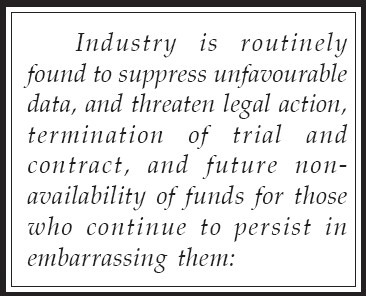
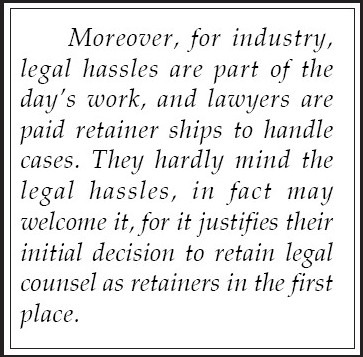
Moreover, for industry, legal hassles are part of the day's work, and lawyers are paid retainer ships to handle cases. They hardly mind the legal hassles, in fact may welcome it, for it justifies their initial decision to retain legal counsel as retainers in the first place. And it suits the lawyers very well too to fight with vigour for their industry client, for it justifies their presence for industry, and makes them inevitable partners in industry's enterprise, almost like insurance. A pain when you pay, but essential relief when you need it. Hence, “Large pharmaceutical companies, on the other hand, may see such legal expenses as a ‘cost of doing business’”(Baird, 2003; Generic gadfly, 2002). And the icing on the cake for industry is that, “Even if a company ultimately loses an action, in effect they win by delaying publication of adverse findings for lengthy periods, and the case serves as a deterrent to others from acting independently” (Baird, 2003).
Appropriate legal counsel by academia on a regular basis and a close study of legal documents before signing is necessary. And a clear understanding of rights of researchers, and the implications of sponsorship, is mandatory.
In other words, have your own lawyer who will take no nonsense from sponsors, and do not allow the patient welfare agenda to be high jacked under any circumstance.
Law Suits against Industry
Efforts to remedy this situation are not entirely absent. A number of lawsuits have been successfully brought up against some pharmaceutical companies. As Studdert, Mello and Brennan (2004) point out about the Lupron case involving TAP Pharmaceuticals and some urologists who connived with them:
In 1997, government investigators began to probe relationships between TAP Pharmaceuticals, a joint venture of Takeda Chemical Industries and Abbott Laboratories, and various urologists for the marketing of Lupron, a potent gonadotropin-releasing hormone agonist used in the treatment of prostate cancer (United States v. TAP Pharmaceuticals, Dec. 14, 2001). The government determined that TAP encouraged the urologists to bill Medicare at the average wholesale price for Lupron, which they received free or at discounted prices. This arbitrage netted the urologists a substantial profit. Federal prosecutors charged TAP with criminal violations of the Prescription Drug Marketing Act. TAP entered into a settlement with the government in which it agreed to pay $290 million in criminal fines plus $585 million in civil penalties. The whistle-blowers received nearly $100 million of the total damages. TAP also faces a series of private class-action lawsuits brought by insurers and patients for unnecessary and costly services.
That the medical people connived and were exposed is as important as the prosecution of the industry player. The Hebrew Faustian story in action.
The pharmaceutical paid fines and penalties of such large sums. What is interesting is that the whistle-blowers too received $ 100 million out of the total amount of $ 875 million. Well, a cool amount for helping enforce ethical conduct. Whoever thought ethics did not pay!
The same authors go on to point out the cascading effect (Studdert, Mello and Brennan, 2004):
The successful prosecution of TAP has spawned a series of other cases. In 2003, AstraZeneca settled criminal-fraud charges of $355 million in a case dealing with the drug Zoladex, a case that involved not only arbitrage issues but also marketing inducements similar to those in the Lupron litigation (Petersen, 2003). On July 14, 2004, Schering-Plough pleaded guilty and paid a fine of $350 million, in part for providing grants private to physicians to conduct educational programs, which prosecutors characterized as kickbacks (Harris, July 16, 2004). Schering-Plough faces an ongoing investigation into whether it used sham consulting arrangements and clinical trials to remunerate physicians for prescribing its hepatitis drug, Intron A (Harris, June 27, 2004 ).Prosecuters’ momentum is unlikely to be slowed by the unsuccessful criminal prosecution of certain TAP employees by the U.S. attorney in Massachusetts. Moreover, the prosecution of specific physicians in this case may add a potent dimension to enforcement (Dembner and Murphy, March 5, 2004; parenthesis added.).
The number of recent lawsuits successfully brought up against industry reflects earnest attempts by patient welfare bodies and others to remedy the tilt. It will result in a newfound confidence in academia that augurs well for academia-industry relationship in the long run. Although one must be careful not to overbalance the other way too. For it is naive to believe that all academia governmental victory is necessarily beneficial to patient welfare. And the cost of litigation is bound to be passed on to patients.
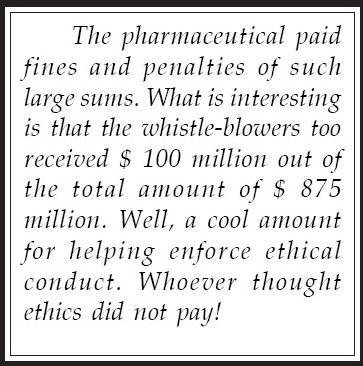
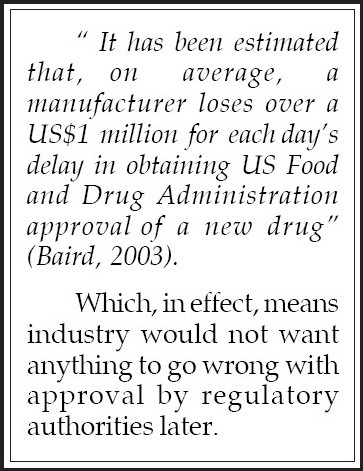
Design and Control of Publication
Another area of pressing concern is when industry decides to both design and control publication of research. “Although particular instances of outright suppression are of concern, much more worrying (although less visible) is the well-documented increasing control by industry over design and publication of clinical trials (Baird, 2003)”. This is so obviously because “it makes commercial sense for large drug companies to create their own study designs”(Baird, 2003). The financial burden on acompany for delay in approval by regulatory authorities has been studied. For example, “It has been estimated that, on average, a manufacturer loses over a US$1 million for each day's delay in obtaining US Food and Drug Administration approval of a new drug” (Baird, 2003). A recent paper reiterates the same when it emphasizes the need for industry to comply with FDA requirements rather than effectiveness of products:
It is important to note that although industry-sponsored research is critical to new product development, its emphasis is on meeting U.S. Food and Drug Administration (FDA) regulatory requirements and on obtaining expanded marketing claims, not on evaluating the effectiveness of products as used in the general population. As a result, industry-sponsored research often fails to address broad public health needs or the needs of individual practitioners seeking to make good clinical decisions for individual patients (March, Silva, Compton, Shapiro, Califf and Krishnan, 2005).
Which, in effect means industry would not want anything to go wrong with approval by regulatory authorities later. Therefore, we should not be surprised at moves by industry to try to take more control of research, (Baird, 2003), all the way from design and methods, through analysis, data presentation and publication vehicle (Montaner, O’Shaughnessy and Schechter, 2001). (Baird, 2003)
Connection between Funding and Positive Findings
Another area worth touching over here is how industry funding decides what sorts of findings get published. There is a strong connection between funding and positive findings for the sponsoring company's product. Numerous studies and literature reviews show the systemic influence of industry funding, with a correlation between funding by the manufacturers and findings that show results supportive in terms of efficacy and safety of the sponsor's products (Davidson, 1986; Rennie, 1999; Deyo, Psaty, Simon, Wagner and Omenn, 1997; Friedberg, Saffran, Stinson, Nebon and Bennett, 1999; Bekelman, Li and Gross, 2003; Stelfox, Chua, O’Rourke and Detsky, 1998). (Baird, 2003)
Which, in effect means, better find positive correlation between my product and your findings, if you want funding renewal and continued support later. And fund seekers are quick on the uptake here, for a pariah from one pharmaceutical company for this reason is hardly likely to be welcome in any other. In this matter, common interests of industry barons help close the ranks even amongst sworn rivals.
How the intellectual dishonesty is carried out to suit sponsor's interest maybe by some rather ingenious means. “A sponsor's drug at high doses may be compared with lower doses of a competing product, or with a poorly absorbed preparation, or it may be tested in patients who are younger and healthier than patients who typically have the disease, thus reducing the likelihood of adverse events.”(Bero and Rennie, 1996; Bodenheimer, 2000; Gotzsche, 1989). (Baird, 2003)
Such dishonesty may easily pass off as genuine research, and can get exposed only if we are vigilant about the material and methods reported by researchers, and question them very closely on such issues. This is as applicable to peer reviewers as to editors, and readers too. The useful rule of thumbi s: keep the critical antenna on, especially with regard to drug trials, and more especially their methodology, and study closely the conflict of interest disclosed, and if possible undisclosed, before you jump on the band wagon to herald the next great wonder drug. While this should not become a reason to debunk all drug trials, it is necessary to avoid getting taken for a ride; and only a healthy skepticism always, coupled with a cautious optimism, can ensure it.
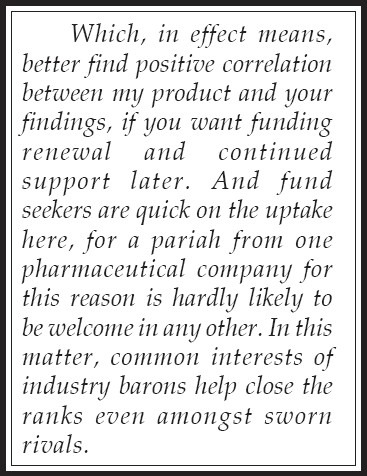
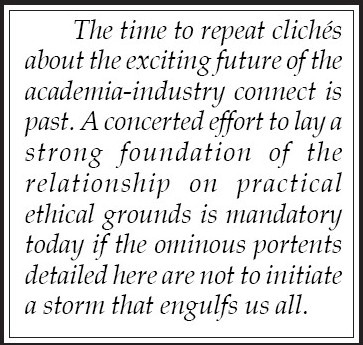
As we end this monograph, the feelings are mixed. The nefarious influences we detail leave a bad taste, but certain remedial steps taken promise hope for the future. The time to repeatcliches about the exciting future of the academia-industry connect is past. A concerted effort to lay a strong foundation of the relationship on practical ethical grounds is mandatory today if the ominous portents detailed here are not to initiate a storm that engulfs us all.
Concluding Remarks
As things stand today, whether we like it or not, industry funding is on the upswing. The whole enterprise of medicine in booming, and it makes sense for industry to invest more and more of one's millions into it. The great role that the pharmaceutical industry is playing today, and will continue to play in the future, can be gauged from the fact that it is the single largest direct funding agency of medical research in Canada, the United Kingdom and the United States.
Conflicts of interest between academia and industry are inevitable at times is acceptable as a statement of fact but not as a state of affairs . The crucial point is that the goals of academia and industry differ. It is academia which has to call the shots, it is industry which has to play second fiddle, and make its millions playing it. Issues like risk, adjuncts, maintenance, discontinuation and transfer to clinical use concern practitioners, but are not likely to motivate industry-sponsored research. It means research agendas of industry are out of tune with needs of clinicians and patients, but still manage to determine what research gets done.
The crucial decision is whether the public welfare agenda of academia, or the corporate research agenda of industry, should occupy center stage when they conflict. The need to protect its right to publish finding even if contrary to industry interests is a crucial determining factor with regard to forwarding the public welfare agenda. In fact, lesson number one in academia-industry relationship is: incorporate the right to publish contrary findings in the research contract itself. Which means, it makes great sense for academia to concentrate on the language and contractual provisions of sponsored research, to read the fine print very closely, and protect their research interests in case of conflict.
There is enough evidence to show that funding by industry is very systematic, and results that are supportive of the safety and efficacy of sponsor's products alone get the funds. It is no surprise, therefore, that very few negative drug trials reports get published, and whatever do, are likely to be by rival companies to serve their commercial interests.
Legal hassles are becoming all too common. A recent paper makes the point clearly in the case of the AIDS vaccine, Remune, in which the researchers concerned filed negative reports and had to face legal action by the sponsor. The way in which many from academia played into the hands of industry in the recent Nancy Olivieri case who had to face legal hassles for whistle blowing on industry is a sad commentary on how money and grants rule the minds of academia at the cost of patient welfare.
However, a number of lawsuits successfully brought up against industry recently reflect earnest attempts by patient welfare bodies and others to remedy the tilt. It will result in a new found confidence in academia that augurs well for academia-industry relationship in the long run. Hence the second lesson for academia: do not get browbeaten by threats of legal action.
Industry commonly decides which clinical research/trial gets done, not academia, much though the latter may wish to believe otherwise. It finds willing researchers to carry this out. This can be one area of concern. Another area of pressing concern is when industry decides to both design and control publication of research.
Companies may be selective in publishing results, and they may delay or not publish unfavourable results at all. The remedy that comes to mind is for academia not to hand over findings, but to insist on working over the research right from methodology through to statistical analysis and eventual publication. Well, does that ensure funds to academia? It does, because if what are legitimate findings are published, the concerned sponsor will know whether the product indeed has business potential, or is just a red herring. And will be on the right track to pump in his millions to market it.
Hence lesson number three: Academia should keep itself involved right from inception of the clinical trial through to ultimate publication. And this must be an integral part of the written contract.
Publishing only positive findings, fudging with figures or reporting incomplete figures to suit predestined conclusions, making convenient conclusions from insufficient data are some related forms of scientific misconduct that serious researchers have to keep away from. Another area of pressing concern is when industry decides to both design and control publication of research. Which, is usually because industry would not want anything to go wrong with approval by regulatory authorities later.
As regards other related forms of scientific misconduct, it makes sense for researchers to refuse to allow commercial interests to rule research reporting. Research having been reported, the commercial implications of such reporting is industry's concern. But, doctoring of findings to suit commerce is to be resisted at all costs.
The negative consequence of promoting the patient welfare agenda is that both industry and academic institutions may gang up to discredit researchers. The suggestion of a more effective conflict of interest policy and complete disclosure of industry relations is worthy of implementation.
The academia-industry relationship is indeed like a porcupine dance which academia takes part in to its own peril if it is not forearmed. And it can seriously harm itself if the industry porcupine is approached unprotected. For the quills of commercial interests can hurt when least expected, and when one is most proximal. So dance carefully with the porcupine.
Appropriate legal counsel by academia on a regular basis and a close study of legal documents before signing, is necessary. And a clear understanding of rights of researchers, and the implications of sponsorship, is mandatory. In other words, have your own lawyer, and do not allow the patient welfare agenda to be high jacked under any circumstance.
Industry is routinely found to suppress unfavourable data, and threaten legal action, termination of trial and contract, and future non-availability of funds for those who continue to persist in embarrassing them.
There is a strong connection between funding and positive findings for the sponsoring company's product. Numerous studies and literature reviews show the systemic influence of industry funding, with a correlation between funding by the manufacturers and findings that show results supportive in terms of efficacy and safety of the sponsor's products.
The useful rule of thumb is: Keep the critical antenna on, especially with regard to drug trials, and more especially their methodology, and study closely the conflict of interest disclosed, and if possible undisclosed, before you jump on the band wagon to herald the next great wonder drug
The time to repeat clichés about the exciting future of the academia-industry connect is past. A concerted effort to lay a strong foundation of the relationship on practical ethical grounds has become mandatory.[54]
Questions that this monograph raises
Do the goals of academia and industry really differ? Can they be one?
It is fine to say the public welfare agenda of academia and not the corporate research agenda of industry, should occupy center stage when they conflict. How do we ensure it?
If funding by industry is very systematic, and results that are supportive of the safety and efficacy of sponsor's products alone get the funds, what can academia do to get the funds and yet not be bullied into publishing only supportive evidence?
What can be done so that even negative drug trials reports get published?
Legal hassles are becoming all too common. This happened recently in the case of the AIDS vaccine, Remune, in which the researchers concerned filed negative reports and had to face legal action by the sponsor. What can academia do so as not to get browbeaten by threats of legal action?
How can academia decide to both design and control publication of research?
If academia decides not to hand over findings, and insists on working over the research right from methodology through to statistical analysis and eventual publication, will it still manage to get the finds it seeks from industry?
Publishing only positive findings, fudging with figures or reporting incomplete figures to suit predestined conclusions, making convenient conclusions from insufficient data are some related forms of scientific misconduct that serious researchers have to keep away from. What measures will ensure this happens?
If researchers refuse to allow commercial interests to rule research reporting, and insist that the commercial implications of such reporting is industry's concern only after research has been reported, will it be a viable option?
The academia-industry relationship is indeed like a porcupine dance which academia takes part in to its own peril if it is not forearmed. And it can seriously harm itself if the industry porcupine is approached unprotected. Can academia decide not to dance with the porcupine, or should it continue to do so with due precautions?
Can academia ensure the patient welfare agenda is not high jacked under any circumstances?
Can academia ensure that cases like the Olivieri and Healy cases do not recur? How?
What can be done so that academia takes appropriate legal counsel on a regular basis and does a close study of legal documents before signing?
Industry is routinely found to suppress unfavourable data, and threaten legal action, termination of trial and contract, and future non-availability of funds for those who continue to persist in embarrassing them. Can academia still embarrass them for patient welfare? How do they do so without jeopardizing future research grants?
Numerous studies and literature reviews show the systemic influence of industry funding, with a correlation between funding by the manufacturers and findings that show results supportive in terms of efficacy and safety of the sponsor's products. What does academia do to publish findings at variance with these objectives? Should it at all do so, or remain loyal to its sponsors?
It is true readers must keep the critical antenna on, especially with regard to drug trials, and more especially their methodology, and study closely the conflict of interest disclosed, and if possible undisclosed. But do they really have a choice not to be influenced by an academia-industry connect so well accepted and espoused all over?
Is there another way of looking at this problem?
Footnotes
Medical Practice, Psychiatry and the Pharmaceutical Industry: And Ever the Trio Shall Meet-II
*See also : The Two Revolution in Bio-Medical Research, p vii-ix
Note :
*1. The basis of the Faust story is that he sold his soil to the Devil in return for twenty-four years of further life during which he is to have every pleasure and all knowledge at his command. The climax comes when the Devil claims him as his own (p418)
**2. Goethe's Faust (1772-1831) is founded on Dr. Johann Faust, or Faustus, a magician and astrologer, who was born in Wurttemberg and died in 1538, and about whom many stories soon began to circulate crediting him with supernatural gifts and evil living.… It was Goethe who was responsible for transforming the necromancer into a personification of the struggle between the higher and lower natures in man (p417).
All page numbers from Evans (1981).
***3. The Wooden Horse of Troy: VIRGIL tells us that, after the death of HECTOR, ULYSSES had a monster horse made by Epios and gave it out that it was an offering to the gods to secure a prosperous voyage back to Greece. The Trojans dragged the horse within their city, but it was full of Grecian soldiers, including MENELAUS, who stole out at night, slew the guards, opened the city gates, and set fire to TROY (p568).
****4. He is a regular Trojan: A fine fellow, with courage and spirit, who works very hard at some uncongenial task, indeed, doing more than could be expected of him. The Trojans in Homer's ILIAD and Virgil's AENID are described as truthful, brave, patriotic, and confiding (p1138).
All page numbers from Evans (1981)
References
- 1.Angell M. Is Academic Medicine for Sale? 2000. N Engl J Med. 2000;342(20):1516–1518. doi: 10.1056/NEJM200005183422009. [DOI] [PubMed] [Google Scholar]
- 2.Angell M. The truth about the drug companies: how they deceive us and what to do about it. New York: Random House; 2004. [Google Scholar]
- 3.Baird P. Getting it right: industry sponsorship and medical research, CMAJ. 2003;168(10):1267–1269. [PMC free article] [PubMed] [Google Scholar]
- 4.Barnes D., Bero L. Scientific quality of original research articles on environmental tobacco smoke. Tob Control. 1997;6:19–26. doi: 10.1136/tc.6.1.19. [DOI] [PMC free article] [PubMed] [Google Scholar]
- 5.Barnes D., Bero L. Why review articles on the health effects of passive smoking reach different conclusions. JAMA. 1998;279:1566–1570. doi: 10.1001/jama.279.19.1566. [DOI] [PubMed] [Google Scholar]
- 6.Baylis F. The Olivieri debacle: where were the heroes of bioethics? The Olivieri Symposium. J Med Ethics. 2004;30:44–49. doi: 10.1136/jme.2003.005330. [DOI] [PMC free article] [PubMed] [Google Scholar]
- 7.Bekelman J.E., Li Y., Gross C.P. Scope and impact of financial conflicts of interest in biomedical research. JAMA. 2003;289:454–65. doi: 10.1001/jama.289.4.454. [DOI] [PubMed] [Google Scholar]
- 8.Bero L., Rennie D. Influences on the quality of published drug studies. Int J Technol Assess Health Care. 1996;12(2):209–37. doi: 10.1017/s0266462300009582. [DOI] [PubMed] [Google Scholar]
- 9.Bevan J.C. Ethical behaviour of authors in biomedical journalism. Ann R Coll Phys Surg Can. 2002;35(2):81–5. [PubMed] [Google Scholar]
- 10.Bodenheimer T. Uneasy alliance — clinical investigators and the pharmaceutical industry. N Engl J Med. 2000;342(20):1539–1544. doi: 10.1056/NEJM200005183422024. [DOI] [PubMed] [Google Scholar]
- 11.Boyd E.A., Cho M.K., Bero L.A. Financial Conflict-of-Interest Policies in Clinical Research: Issues for Clinical Investigators. Academic Medicine. 2003;78:769–774. doi: 10.1097/00001888-200308000-00002. [DOI] [PubMed] [Google Scholar]
- 12.Chalmers I. Underreporting research is scientific misconduct. JAMA. 1990;263:1405–1408. [PubMed] [Google Scholar]
- 13.Cho M.K., Bero L.A. The quality of drug studies published in symposium proceedings. Ann Intern Med. 1996;124:485–489. doi: 10.7326/0003-4819-124-5-199603010-00004. [DOI] [PubMed] [Google Scholar]
- 14.Collier J., Iheanacho I. The pharmaceutical industry as an informant. Lancet. 2002;360:1405–1409. doi: 10.1016/S0140-6736(02)11394-8. [DOI] [PubMed] [Google Scholar]
- 15.Davidson R.A. Source of funding and outcome of clinical trials. J Gen Intern Med. 1986;1(3):155–158. doi: 10.1007/BF02602327. [DOI] [PubMed] [Google Scholar]
- 16.Dembner A, Murphy S. Clinic's ex-CEO said to be in talks to avoid charges. Boston Globe. 2004 Mar 5;:A1. [Google Scholar]
- 17.Deyo R.A, Psaty B.M., Simon G., Wagner E.H., Omenn G.S. The messenger under attack – intimidation of researchers by special interest groups. N Engl J Med. 1977;336(16):1176–1180. doi: 10.1056/NEJM199704173361611. [DOI] [PubMed] [Google Scholar]
- 18.Downie J., Thompson J., Baird P. The Olivieri Report: the complete text of the report of the independent inquiry commissioned by the Canadian Association of University Teachers. 2nd ed. Toronto: James Lorimer and Company; 2001. [Google Scholar]
- 19.Drazen J.M. Institutions, contracts and academic freedom. N Engl J Med. 2002;347:1362–1363. doi: 10.1056/NEJMe020122. [DOI] [PubMed] [Google Scholar]
- 20.Encyclopaedia Britannica 2005 Standard (2005) Drug Research, in Clinical Research, The Practice of Modern Medicine, 2 CD Set. Also in Macropaedia. 1990;23:910. [Google Scholar]
- 21.Evans I.H. Brewer's Dictionary Of Phrase And Fable. Second (revised) edition. London: Second impression, Cassell; 1981. [Google Scholar]
- 22.Faunce T., Bolsin S., Chan W-P. Supporting whistleblowers in academic medicine: training and respecting the courage of professional conscience, The Olivieri Symposium. J Med Ethics. 2004;30:40–43. doi: 10.1136/jme.2003.006940. [DOI] [PMC free article] [PubMed] [Google Scholar]
- 23.Friedberg M., Saffran B., Stinson T.J., Nebon W., Bennett C.L. Evaluation of conflict of interest in economic analyses of new drugs used in oncology. JAMA. 1999;282(15):1453–1457. doi: 10.1001/jama.282.15.1453. [DOI] [PubMed] [Google Scholar]
- 24.Generic gadfly. Economist. 2002 Apr 11; [Google Scholar]
- 25.Gotzsche P.C. Methodology and overt and hidden bias in reports of 196 double-blind trials of nonsteroidal anti-inflammatory drugs in rheumatoid arthritis. Control Clin Trials. 1989;10:31–56. doi: 10.1016/0197-2456(89)90017-2. [DOI] [PubMed] [Google Scholar]
- 26.Hailey D. Scientific harassment by pharmaceutical companies: time to stop. CMAJ. 2000;162:212–213. [PMC free article] [PubMed] [Google Scholar]
- 27.Harris G. Guilty plea seen for drug maker. New York Times. 2004a Jul 16;:A1. [Google Scholar]
- 28.Harris G. As doctor writes prescription, drug company writes a check. New York Times. 2004b Jun 27;:A1. [PubMed] [Google Scholar]
- 29.Hilts P. Drug firm, scientists clash over HIV study. Chicago Tribune. 2000 Nov 1;:pN4. [Google Scholar]
- 30.Kahn J.O., Cherng D.W., Mayer K., Murray H., Lagakos S. Evaluation of HIV-1 immunogen, an immunologic modifier, administered to patients infected with HIV having 300 to 549×106/L CD4 cell counts: a randomized controlled trial. JAMA. 2000;284:2193–2202. doi: 10.1001/jama.284.17.2193. [Erratum, JAMA 2001, 285, p2197.] [DOI] [PubMed] [Google Scholar]
- 31.Lee N. UCSF, Immune Response drop countersuits. San Diego Bus J. 2001;39:14. [Google Scholar]
- 32.Lewis S., Baird P., Evans R.G., Ghali W.A., Wright C.J., Gibsons E., Baylis F. Dancing with the porcupine: rules for governing the university-industry relationship [editorial] CMAJ. 2001;165(6):783–785. [PMC free article] [PubMed] [Google Scholar]
- 33.March J.S., Silva S.G., Compton S., Shapiro M., Califf R., Krishnan R. The Case for Practical Clinical Trials in Psychiatry. Am J Psychiatry. 2005;162:836–846. doi: 10.1176/appi.ajp.162.5.836. [DOI] [PubMed] [Google Scholar]
- 34.Meier B. Contracts keep drug research out of reach. New York Times. 2004 Nov 29;:pA1. [PubMed] [Google Scholar]
- 35.Mello M.M., Clarridge B.R., Studdert D.M. Academic Medical Centers’ Standards for Clinical-Trial Agreements with Industry. N Eng J Med. 2005;35(21):2202–2210. doi: 10.1056/NEJMsa044115. [DOI] [PubMed] [Google Scholar]
- 36.Montaner J.S.G., O’Shaughnessy M.V., Schechter M.T. Industry-sponsored clinical research: a double-edged sword. Lancet. 2001;358:1893–1895. doi: 10.1016/S0140-6736(01)06891-X. [DOI] [PubMed] [Google Scholar]
- 37.Nathan D.G., Weatherall D.J. Academic freedom in clinical research (editorial) N Engl J Med. 2002;347:1368–1371. doi: 10.1056/NEJMsb020394. [DOI] [PubMed] [Google Scholar]
- 38.Petersen M. AstraZeneca pleads guilty in cancer medicine scheme. New York Times. 2003 Jun 21;:pC1. [Google Scholar]
- 39.Rennie D. Fair conduct and fair reporting of clinical trials. JAMA. 1999;282(18):1766–1768. doi: 10.1001/jama.282.18.1766. [DOI] [PubMed] [Google Scholar]
- 40.Rennie D. Thyroid storm. JAMA. 1997;277:1238–1243. [PubMed] [Google Scholar]
- 41.Saltus R. AIDS drug researchers say firm pressured them: findings published, but fight goes to court. Boston Globe. 2000 Nov 1;:pA3. [Google Scholar]
- 42.Schafer A. Biomedical conflicts of interest: a defence of the sequestration thesis—learning from the cases of Nancy Olivieri and David Healy. J Med Ethics. 2004;30:8–24. doi: 10.1136/jme.2003.005702. [DOI] [PMC free article] [PubMed] [Google Scholar]
- 43.Shuchman M. Legal issues surrounding privately funded research cause furore in Toronto. CMAJ. 1998;159:983–986. [PMC free article] [PubMed] [Google Scholar]
- 44.Schulman K.A., Seils D.M., Timbie J.W., Sugarman B.A., Dame L.A., Weinfurt K.P., Mark D.B., Califf R.M. A national survey of provisions in clinical-trial agreements between medical schools and industry sponsors. N Engl J Med. 2002;347(17):1335–1341. doi: 10.1056/NEJMsa020349. [DOI] [PubMed] [Google Scholar]
- 45.Singh A.R., Singh S.A. Replicative Nature of Indian Research, Essence of Scientific Temper, and Future of Scientific Progress. Psychiatry, Science, Religion and Health, MSM Annual. 2004 May-Oct;II(1-3):57–69. [PMC free article] [PubMed] [Google Scholar]
- 46.Singh A.R., Singh S.A. Psychiatry, Medical Practice and the Pharmaceutical Industry: And Ever the Trio shall Meet-I: The Connection between Academia and Industry. Mens Sana Monographs. 2005 Mar-Jun;II, III(6, 1):5–35. doi: 10.4103/0973-1229.27876. [DOI] [PMC free article] [PubMed] [Google Scholar]
- 47.Skolnick A.A. Drug firm suit fails to halt publication of Canadian health technology report. JAMA. 1998;280(8):683–684. [PubMed] [Google Scholar]
- 48.Stelfox H.T., Chua G., O’Rourke K., Detsky A.S. Conflict of interest in the debate over calcium-channel antagonists. N Engl J Med. 1998;338(2):101–106. doi: 10.1056/NEJM199801083380206. [DOI] [PubMed] [Google Scholar]
- 49.Stern J.M., Simes R.J. Publication bias: evidence of delayed publication in a cohort study of clinical research projects. BMJ. 1997;315:640–645. doi: 10.1136/bmj.315.7109.640. [DOI] [PMC free article] [PubMed] [Google Scholar]
- 50.Studdert D.M., Mello M.M., Troyen A., Brennan T.A. Financial Conflicts of Interest in Physicians’ Relationships with the Pharmaceutical Industry — Self-Regulation in the Shadow of Federal Prosecution. N Engl J Med. 2004;351(18):1891–1900. doi: 10.1056/NEJMlim042229. [DOI] [PubMed] [Google Scholar]
- 51.Topol E.J. Failing the public health — rofecoxib, Merck, and the FDA. N Engl J Med. 2004;351:1707–1709. doi: 10.1056/NEJMp048286. [DOI] [PubMed] [Google Scholar]
- 52.United States v. TAP Pharmaceuticals (2001) Sentencing memorandum of the United States, Criminal Action No. 01-CR-10354-WGY. 2001 Dec 14; [Google Scholar]
- 53.Wager E. How to dance with porcupines: rules and guidelines on doctors’ relations with drug companies. BMJ. 2003;326:1196–1198. doi: 10.1136/bmj.326.7400.1196. [DOI] [PMC free article] [PubMed] [Google Scholar]
- 54.Worthen D.B. The pharmaceutical industry 1852–1902; 150 years of pharmacy—a special JAPhA series. J Am Pharm Assoc. 2000;40(5):589–591. [PubMed] [Google Scholar]


